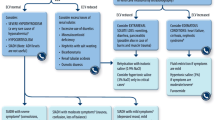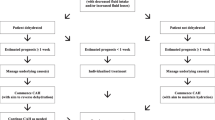Abstract
As the world’s population ages, chronic and degenerative diseases are rising. This scenario demands the development of new treatment techniques with lower costs, which are as efficient as the existing ones.
Hypodermoclysis is the infusion of fluids into the subcutaneous tissue with a butterfly needle. This technique may be used for isotonic fluid replacement and to administer cytosine arabinoside, clodronate, antibiotics and narcotic analgesics.
This review evaluates the evidence supporting the use of hypodermoclysis to treat elderly patients with dehydration and patients with terminal cancer, and discusses its indications, adverse effects and perspectives. A MEDLINE search of the last 30 years was done to recover all available literature.
Hypodermoclysis therapy is a safe and effective method to provide fluids and narcotic analgesic therapy in elderly patients that are mild and moderate dehydrated and in patients with cancer. It seems a good option to provide antibiotics, but there is a need for more studies to evaluate this indication.
Similar content being viewed by others
References
Farrand S, Campbell AJ. Safe, simple subcutaneous fluid administration. Br J Hosp Med 1996; 55(11): 690–2
Noble-Adams R. Dehydration: subcutaneous fluid administration. Br J Nurs 1995; 4(9): 488–94
Gaisford W, Evans DG. Hyaluronidase in paediatric therapy. Lancet 1949; II: 505–8
Abbot WE, Levey S, Foreman RC. The danger of administration parenteral fluids by hypodermoclysis. Surgery 1952; 32: 305–7
Olde-Rikkert MG, Bogaers MA, Bruijns E. Hypodermoclysis and undervalued rehydration methods in geriatrics. Tijdschr Gerontol Geriatr 1994; 25(5): 197–204
Berger EY. Nutrition by hypodermoclysis. J Am Geriatr Soc 1984; 32: 199–203
Fainsinger RL, MacEachern T, Miller MJ, et al. The use of hypodermoclysis for rehydration in terminally ill cancer patients. J Pain Symptom Manage 1994; 9(5): 298–302
Rochon PA, Gill SS, Litner J, et al. A systematic review of the evidence for hypodermoclysis to treat dehydration in older people. J Gerontol A Biol Sci Med Sci 1997; 52(3): M169–76
Ashby M., Fleming BG, Keam E, et al. Subcutaneous fluid infusion (hypodermoclysis) in palliative care: new role for an old trick [letter]. Med J Aust 1992; 156(9): 669
Constant T, Dutertre JP, Froge E. Hypodermoclysis in dehydrated elderly patients: local effects with and without hyaluronidase. J Palliat Care 1991; 7(2): 10–2
Schen RJ. Subcutaneous infusion in the elderly. BMJ 1981; 282: 823–4
Schen RJ, Singer-Edelstein M. Hypodermoclysis in elderly patients. JAMA 1983; 250(13): 1694–8
Schen RJ. Subcutaneous infusions in the elderly [letter]. J Am Geriatr Soc 1991; 39: 1044–5
Schen RJ, Arieli S. Administration of potassium by subcutaneous infusion in elderly patients. BMJ 1982; 285: 1167–8
Schen RJ, Singer-Edelstein M. Subcutaneous infusions in the elderly. J Am Geriatr Soc 1981; 24: 583–5
Simpson RG. Hyaluronidase in geriatric therapy. Practitioner 1977; 219: 361–3
Mancini I, Body JJ. Hypodermoclysis, a neglected approach. Ver Med Brux 1998; 19(4): A327–31
Schen RJ. Subcutaneous fluid infusion (hypodermoclysis) in palliative care [letter]. Med J Aust 1993; 158: 796
Steiner N, Bruera E. Methods of hydration in palliative care patients. J Palliat Care 1998; 14(2): 6–13
Bruera E, Legris MA, Kuehn N, et al. Hypodermoclysis for the administration of fluids and narcotic analgesic in patients with advanced cancer. J Natl Cancer Inst 1989; 81(14): 1108–9
Fainsinger RL, Bruera E. Hypodermoclysis (HDC) for symptom control vs The Edmonton Injector (EI). J Palliat Care 1991; 7(4): 5–8
Walker P, Watanabe S, Lawlor P, et al. Subcutaneous clodronate: a study evaluating efficacy in hypercalcemia of malignancy and local toxicity. Ann Oncol 1997; 8(9): 915–6
Lipschitz S, Campbell AJ, Roberts MS. Subcutaneous fluid administration in elderly subjects: validation of an under-used technique. J Am Geriatr Soc 1991; 39: 6–9
Roberts MS, Lipschitz S, Campbell AJ, et al. Modeling of subcutaneous absorption kinetics of infusion solutions in the elderly using technetium. J Pharmacokinet Biopharm 1997; 25(1): 1–21
Challiner YC, Jarret D, Hayward MJ. A comparison of intravenous and subcutaneous hydration in elderly acute stroke patients. Postgrad Med J 1994; 70; 195–7
Weinstein HJ, Griffin TW, Feeney J, et al. Pharmacokinetics of continuous intravenous and subcutaneous infusions of cytosine arabinoisde. Blood 1982; 59(6): 1351–3
Champoux N, Du Souich P, Ravaoarinoro M, et al. Single dose pharmacokinetics of ampicillin and tobramycin administered by hypodermoclysis in young and older healthy volunteers. Br J Clin Pharmacol 1996; 42(3): 325–31
Molloy DW, Cunje A. Hypodermoclysis in the care of older adults: an old solution for new problems. Can Fam Physician 1992; 38: 2038–43
Gluck SM. Hypodermoclisis revisited. JAMA 1982; 248: 1310–1
Abdulla A, Keast J. Hypodermoclysis as a means of rehydration. Nurs Times 1997; 93(29): 54–5
Hussain NA, Warshaw G. Utility of clysis for hydratation in nursing home residents. J Am Geriatr Soc 1996; 44: 969–73
Bruera E, Legris MA, Kuehn N, et al. Hypodermoclysis for the administration of fluids and narcotics analgesics in patients with advanced cancer. J Pain Symptom Manage 1990; 5(218): 218–20
Gluck SM. Advantages of hypodermoclysis [letter]. J Am Geriatr Soc 1991; 32: 691–2
Hays H. Hypodermoclysis and system management [letter]. Can Fam Physician 1993; 39: 245
Author information
Authors and Affiliations
Corresponding author
Rights and permissions
About this article
Cite this article
Frisoli, A., de Paula, A.P., Feldman, D. et al. Subcutaneous Hydration By Hypodermoclysis. Drugs & Aging 16, 313–319 (2000). https://doi.org/10.2165/00002512-200016040-00007
Published:
Issue Date:
DOI: https://doi.org/10.2165/00002512-200016040-00007




